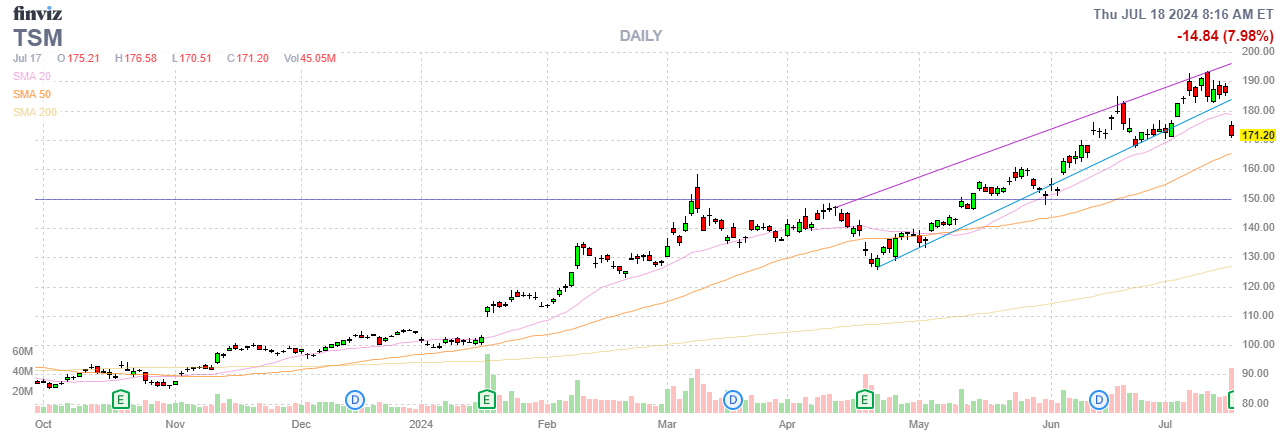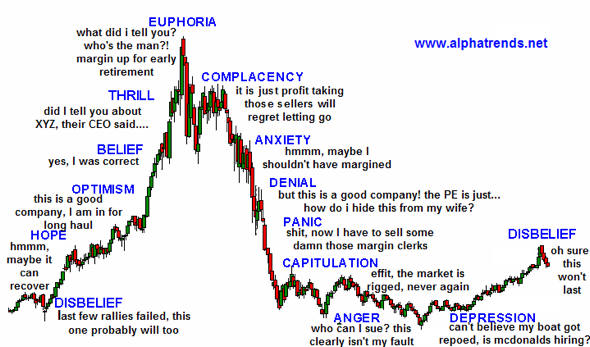 Wheeeee, what a ride!
Wheeeee, what a ride!
The Nasdaq 100 finished down 599 points yesterday and that is down 3% from the day before and 3.8% down from 20,886 on July 11th – just 7 days ago. Just this morning, Taiwan Semiconductor (TSM) blew away expectations with profits soaring 36% on robust AI chip demand yet the stock is trading around $174 – only slightly improved from yesterday’s 8% ($15) drop to $171.20 after Trump said the US should not defend Taiwan unless they pay us protection money (cash, in a bag, each Friday).

TSM is still up 70% for the year but on a path to make $6/share this year so trading at 28.5x current earnings makes them relatively cheap for a Nasdaq component – as the rest of the index is closing in on 40x. Of course, no one thinks NVDA is going to be taken over by China but both Biden and Trump don’t want them doing business with China and that puts a bit of a dent in everyone’s expansion plans.
On the whole, the Nasdaq is simply completing the drop we expected (to 19,875) from the chart I made on the 11th, when it first began to falter. The problem faced by the Nasdaq – as well as the other indexes is a pesky little thing called reality. It is relatively easy to jack up the prices of stocks in the short-term because the stock’s price is based on the last transaction – even though that may have been 100 shares out of 1Bn total shares.

So, if someone sells 100 TSM for $171.20 – that’s going to reprice the entire float of 5.19Bn shares at $171.20 for a Market Cap of $888.528Bn. That’s $71Bn lower than it was the day before just because 100 shares ($17,120) was traded at $171.20 at the end of the day.
It wasn’t actually that dramatic. The stock fell all day long and a total of 42.9M (0.82%) shares ($7.34Bn) turned over but consider that there WAS a buyer for every seller so the price movement is caused by a very small fraction of marginal shares being sold – nothing like the day’s total (outflow).

Market sentiment, the psychological aspect of market behavior, is clearly influencing both TSM and the broader Nasdaq 100. The sharp decline in TSM’s stock price, despite beating earnings expectations, underscores the power of Market Psychology. This aligns with Behavioral Finance Theories, which posit that markets are often inefficient due to psychological and social factors.

The Nasdaq 100’s overall movement can be understood through the lens of Market Microstructure Theory. The index’s price is determined by the aggregate of its components, each subject to their own supply and demand dynamics. The marginal trades, as highlighted in TSM’s case, can have outsized impacts on overall market capitalization due to the way stock prices are calculated based on the last transaction.
This price discovery process, while efficient in incorporating new information, can lead to short-term volatility that may not reflect the underlying economic value of the companies involved. The current market dynamics in the Nasdaq 100 suggest a recalibration of Risk Premiums and Growth Expectations across the technology sector, driven by a combination of Fundamental Reassessments, Technical Factors, and Shifting Market Sentiment.
As we navigate this period of heightened volatility, it’s crucial to remember that while short-term price movements can be dramatic, LONG-TERM stock performance tends to align more closely with fundamental factors. The current market behavior in the Nasdaq 100 and stocks like TSM serves as a vivid illustration of the complex, multifaceted nature of stock price determination in modern financial markets.







